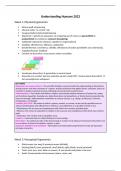Understanding Humans 2022
Week 1: Physical Ergonomics
Natuur geeft ontspanning
Mensen willen “in control” zijn
Voorgeschiedenis beïnvloedt beleving
Ergonomie = gericht op aanpassen van omgeving aan de mens om gezondheid en
productiviteit te verbeteren (systeem benadering)
3 gebieden ergonomie: physical, cognitive en organisational
Usability: effectiveness, efficiency, satisfaction
Donald Norman: consistency, visibility, affordance (all action possibilities are understood),
mapping (fornuis), feedback
Comfort en discomfort: onze sensors meten verschillen
Voorkomen discomfort gewrichten in neutral stand
Discomfort en comfort zijn niet uiteinden op één schaal (LPD = local postural discomfort)
het menselijk brein anticipeert
KEY TERMS
Ergonomics (or human factors) = The scientific discipline concerned with the understanding of interactions
among humans and other elements of a system, and the profession that applies theory, principles, data and
methods to design to optimize human well-being and overall system performance.
Anthropometry = The science that defines, collects, and analyses physical measures of human size, shape,
and functional capacities. Examples are: body dimensions and proportions, or biomechanical properties like
mass and strength. Anthropometry contributes to various sciences, e.g., design, architecture, forensics,
orthopaedics, and biology.
Usability (ISO 9241) =The extent to which a system, product, or service can be used by specified users to
achieve specified goals with effectiveness, efficiency, and satisfaction in a specified context of use.
- Effectiveness: the accuracy and completeness with which users achieve specified goals.
- Efficiency: the resources expended in relation to the accuracy and completeness with which users achieve
goals.
- Satisfaction: The comfort and acceptability of use.
Comfort = A pleasant state or relaxed feeling of a human being.
Discomfort = An unpleasant state of the human body in reaction to its physical environment. Discomfort can
be a predictor of physical complaints, injuries, or pain.
Ergonomic guidelines and standards = Information and (inter)national agreements to help set ergonomic
principles in practice.
Week 2: Perceptual Ergonomics
Distal senses (ver weg) & proximal senses (dichtbij)
Hearing (distal), taste (proximal), smell (distal), sight (distal), touch (proximal)
Taste: zoet, zuur, zout, bitter en umami veel smaak vind plaats in de neus
Smell: Communicatie via feromonen (alarm, route, sex)
, Hearing: perceptual threshold the level of stimulus intensity necessary to be aware of a
particular sensation
Touch: haptics verzamelnaam van gewricht- en spiersensoren (kinaesthetic) en
huidsensoren (tactile), receptoren, materiaal eigenschappen (perceptual attributes)
Sight: kleur (product design: use black on yellow and white on blue), diepte (converging
parallel lines, vertical elevation, atmospheric perspective, relative size and occlusion | gestalt
psychology principles of grouping) en objecten (object recognition by their potential
function, affordance)
KEY TERMS
Distal and proximal senses = A proximal sense makes direct contact with the stimulus, these include touch
and taste. Distal sensing does not need physical contact, these include vision, audition and smell.
Multisensory integration = The ability to integrate signals from different senses to a coherent perception.
(Perception combines signals, based on their dominance/relevance)
Cues = Features that contribute to a percept.
Perceptual threshold = The level of stimulus intensity necessary to be aware of a particular sensation.
Perceptual attributes = The perceived, subjective attributes (e.g., colour, lightness, hardness) of physical,
objective stimuli (e.g., light, sound). Psychophysics deals with the examination of the relationships between
the perceptual attributes and physical stimuli. (materiaal eigenschappen)
Gestalts = An entire perceptual configuration (from German: ‘shape’, ‘configuration’, ‘totality’, ‘form’) made
up of elements that are integrated and interactive in such a way as to confer properties on the whole
configuration that are not possessed by the individual elements.
Affordances = The opportunities for action that an object, environment, or situation offers to a person.
According to Gibson, people do not first perceive an object’s properties, like colour, form or texture, but
rather automatically and directly experience the action possibilities that the object affords or offers them
(Gibson, 1979).
Ventriloquism effect = The perception of speech sounds as coming from a direction other than
their true direction, due to the influence of visual stimuli from a speaker. This generalizes to other sensory
combinations such as attributing smell features to taste. (Iets toekennen op basis van een dominante cue)
Week 3: Cognitive Ergonomics
Cognition includes all conscious and unconscious processes by which knowledge is
accumulated, processed and understood.
Human information processing: turning signals into information
Understanding the cognitive processes and representations involved in human performance
and applying the results to the design end evaluation of work systems.
The intended use of / the interaction with a product should match the cognitive capabilities
of the users in a given situation.
Attention = the cognitive process of selectively concentrating on a discrete aspect of a certain
stimulus ( it helps us filter relevant information)





